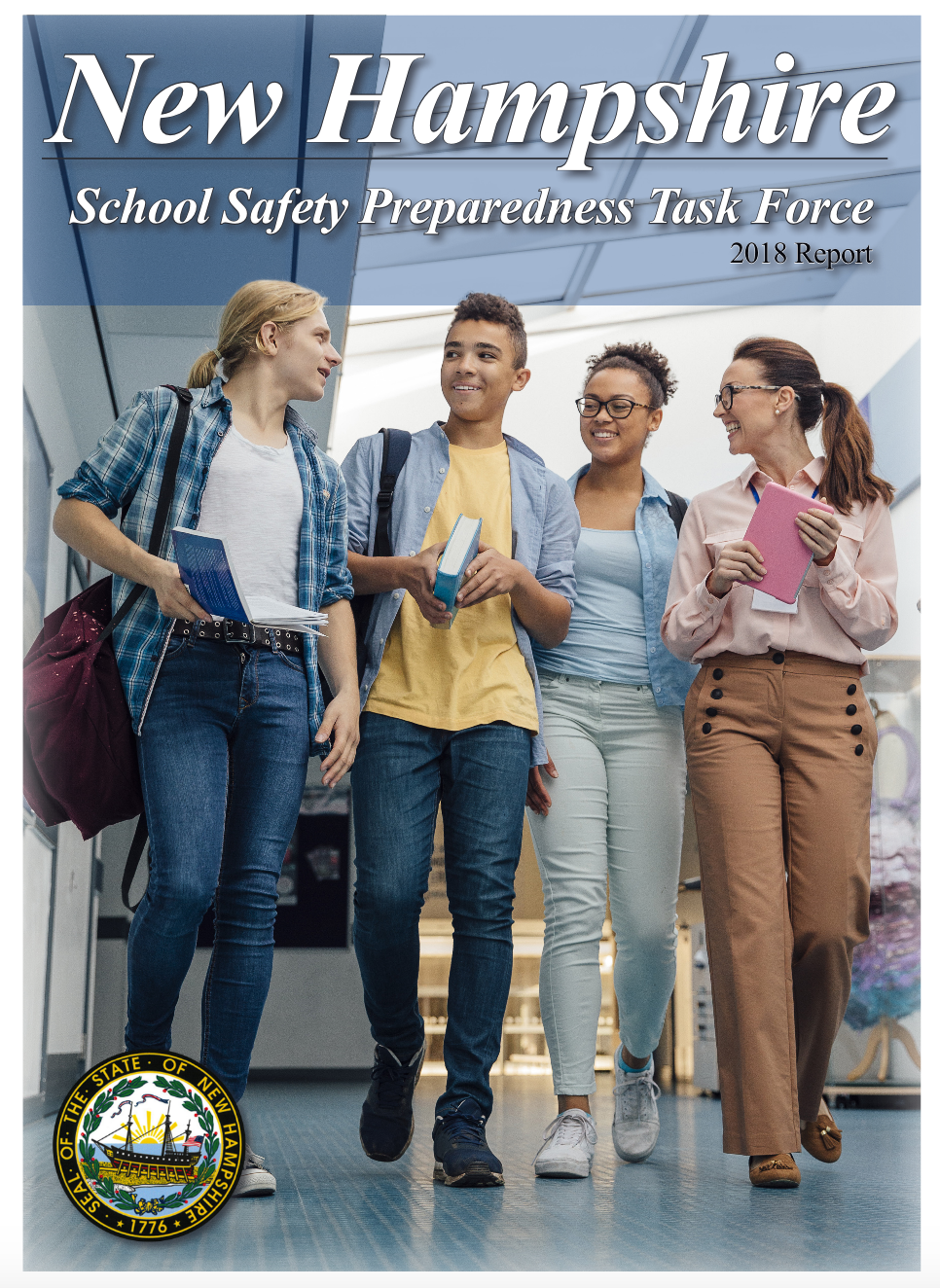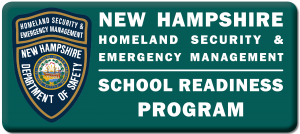Review all 59 of the Task Force recommendations, view the progress made to complete the recommendations and access available resources.
Legislative | ||
| Recommendation 1: Convene a study group to determine if the implementation of extreme risk protection orders is right for New Hampshire. | ||
| Recommendation 2: Convene a study group to examine New Hampshire background checks for the purchase of firearms to determine if changes are needed. | ||
| Recommendation 3: Replace 4 of the 10 required emergency egress drills (fire drills) with all-hazards drills, at least one of which should test emergency response to an armed assailant. |
Mental Health | ||
| Recommendation 4: Improve school culture by expanding social and emotional learning programs in schools at all levels statewide. | ||
| Recommendation 5: Develop an age-appropriate school outreach program that educates staff and students on reducing the stigma of mental illness and what to do when someone is in crisis. | ||
| Recommendation 6: Increase and promote Mental Health First Aid to school staff, students, and families to provide the school community with the resources to effectively manage a mental health incident. | ||
| Recommendation 7: Develop a threat assessment task force at the community or district level that engages the local public health network, including an intervention and reporting protocol that evaluates students quickly and efficiently and provides a plan to help appropriately return students to school. | ||
| Recommendation 8: Increase and promote evidence-based best practice suicide prevention training in schools to provide school staff with the knowledge and skills to recognize individuals at risk, and connect that individual with help. All schools should have specific protocols in place for responding to an individual who is suicidal and for responding to a suicide death in a manner which reduces risk and promotes healing for students and the school community. | ||
| Recommendation 9: Expand programs that focus on creating a positive school climate and atmosphere with structured support for students, such as the Multi-Tiered System for Support and Behavioral Health (MTSS-B) or Positive Behavior Intervention System (PBIS). | ||
| Recommendation 10: Increase existing available mental health resources (e.g., Community Mental Health Centers, or by engaging Public Health Networks) to increase the capacity of services and decrease wait times. | ||
| Recommendation 11: Following a critical school incident, school administrators should consult with the New Hampshire Disaster Behavioral Health Coordinator to ensure an appropriate and trauma-informed post incident response. |
Planning | ||
| Recommendation 12: All school plans submitted under RSA 189:64 shall be reviewed by the State every three years based on current best practices. A feedback report shall be forwarded to the school for voluntary changes. | ||
| Recommendation 13: Continue with the current, voluntary New Hampshire Homeland Security and Emergency Management school assessment process. Provide reassessments at least every three years or when significant changes to the facility, staff, or policy occur. | ||
| Recommendation 14: Reevaluate the Homeland Security and Emergency Management school assessment process every three years to ensure assessors use the latest standards, knowledge, and techniques. | ||
| Recommendation 15: Develop, implement, communicate, and exercise a reunification plan that clearly establishes where and how students will be reunited with their families. | ||
| Recommendation 16: Develop a detailed plan that focuses on keeping students safe when local elections are held in the school building, understanding that individuals will be present on school property who have not been vetted. | ||
| Recommendation 17: Develop a predetermined response to active shooter incidents for first responders and dispatchers to reduce response times by increasing efficiency, coordination, and addressing anticipated problems. | ||
| Recommendation 18: Develop a building specific response plan for active shooter incidents for first responders to reduce response times by increasing efficiency, coordination, and addressing anticipated problems. | ||
| Recommendation 19: Current blueprints (i.e., floor plans) must be submitted to local law enforcement and the Department of Safety in hardcopy or a commonly used digital format. After the initial submission, updates will be provided in a timely manner when changes are made to a building. | ||
| Recommendation 20: Schools should consider installing a secure lock box in a safe location away from the building, such as near the driveway entrance that allows the school to store entrance keys, access cards, and critical documents (e.g., blueprints, floor plans, pre-fire plans, evacuation procedures, shut off valve locations, disclosures of hazardous materials, etc.). | ||
| Recommendation 21: Develop an inventory list for emergency go-kits that schools should create, keep in classrooms, examine and update quarterly such that each teacher will be prepared to evacuate. | ||
| Recommendation 22: Ensure that school safety and communications technologies have maintenance and upgrade plans and all technologies not used frequently are tested quarterly. | ||
| Recommendation 23: Develop a working group comprised of school leaders to share best practices in school safety and establish mentor relationships between schools. |
Training | ||
| Recommendation 24: All school staff and students, including part-time staff, full-time staff, contracted staff and services, coaches, bus drivers, and volunteers should receive training to recognize: 1) behavioral warning signs and pre-incident indicators, and 2) the appropriate steps to evaluate the behavior, provide services, and alert appropriate stakeholders. School staff should receive the training during workshop days. | ||
| Recommendation 25: All school staff and students, including part-time staff, full-time staff, contracted staff and coaches should receive crisis training that is age appropriate for the students and addresses the mental, emotional, and physiological responses they will experience during the onset of a crisis and how to respond to those experiences in a manner that increases their chance of survival. | ||
| Recommendation 26: All staff and students should receive training on a school’s emergency operations plan on a regular basis to ensure staff and students have a clear understanding of roles and responsibilities. Changes and adaptations to the plan should be made as gaps and weaknesses are identified. | ||
| Recommendation 27: School staff should receive a level of Incident Command System training appropriate for their level of interaction with first responders during an event (e.g., teachers may take only IS-100.SCA, Introduction to the Incident Command System for Schools, while administrators would take IS-100.SCA and IS-362.A, Multi-Hazard Emergency Planning for Schools, etc.). | ||
| Recommendation 28: School staff who will perform in a leadership role during an incident should be trained in the predetermined emergency response actions so they know what steps first responders will be taking upon notification of the incident and how to best coordinate efforts with those first responders as they arrive on scene. | ||
| Recommendation 29: Develop a training program for current and future school administrators to receive training in school emergency management and participate in practical exercises. New school administrators should receive this training prior to assuming their new role. | ||
| Recommendation 30: Increase warm zone EMS training for first responders, including fire, EMS, and law enforcement to enhance the ability of all responding entities to work together, ensuring a seamless and safe response. | ||
| Recommendation 31: Where resources allow, each school should have a school resource officer that does not perform other non-school related duties and for which a suitable replacement is available when the school resource officer is unavailable or required to be out of the school. | ||
| Recommendation 32: Develop and implement specialized training for school resource officers in addition to their law enforcement training. Training should focus on unique school issues and its population demographic as well as response to active shooter events. | ||
| Recommendation 33: Establish a study group to examine the feasibility and/or implementation of a School Marshal Program. |
Exercises | ||
| Recommendation 34: Each school should exercise its emergency operations plan on a regular basis to ensure staff and students have a clear understanding of roles and responsibilities. Changes and adaptations to the plan should be made as gaps and weaknesses are identified. | ||
| Recommendation 35: Each school should exercise its active shooter functional annex on a regular basis to ensure staff and students have a clear understanding of roles and responsibilities. Changes and adaptations to the plan should be made as gaps and weaknesses are identified. | ||
| Recommendation 36: School resource officers should exercise their roles in the school’s active shooter functional annex on a regular basis to ensure they have a clear understanding of their roles and responsibilities during an event. If used, school marshals should also conduct these exercises. Changes and adaptations to the plan should be made as gaps and weaknesses are identified. |
Communication | ||
| Recommendation 37: Increase communication capabilities and the interoperability of communication systems to convey information during an emergency to first responders both inside and outside the school. This includes cell phone coverage boosters, radio repeaters, and radio frequency standardization. | ||
| Recommendation 38: Ensure all phones are clearly labeled with 9-1-1, or 9-1-1 preceded by the appropriate prefix to dial out to ensure that anyone will be able to reach E911 quickly and efficiently. | ||
| Recommendation 39: Grant school staff members explicit authority to contact 9-1-1 directly to ensure that E911 is contacted with speed and efficiency. | ||
| Recommendation 40: Ensure classroom phone lines are set up with a unique code (i.e., Direct Inward Dial) and that these codes are recorded in a database shared with E911 so that when a 9-1-1 call is placed, the E911 emergency medical dispatcher will be able to tell exactly which room in the school the call is coming from. | ||
| Recommendation 41: When schools replace, upgrade, or install fire alarms, they should consider the potential of having multifunctional alarms (e.g., separate fire and lockdown alarms) to clearly and quickly inform building occupants of how to take action. | ||
| Recommendation 42: Install or issue panic buttons or other communication technology to directly notify first responders of an incident. | ||
| Recommendation 43: Establish a system to alert parents, staff, and non-first responders during an emergency to quickly and efficiently notify them of current incident and safety information. | ||
| Recommendation 44: Continue with the current Emergency Management Performance Grant (EMPG) to assist public schools and local law enforcement agencies with funding for emergency notification software that will improve and enhance school safety. | ||
| Recommendation 45: Have local law enforcement increase their visibility at schools (e.g., complete reports and other paperwork on school grounds, eat lunch with students in the cafeteria, etc.) to increase informal interactions and trust with the students. | ||
| Recommendation 46: Launch an age appropriate See Something, Say Something™ style campaign in schools to inform students about warning signs and pre-incident indicators, and the need to report them to appropriate adults, as well as helping students feel comfortable when alerting appropriate adults. | ||
| Recommendation 47: Establish a confidential or anonymous tip line to increase information sharing from students. | ||
| Recommendation 48: The New Hampshire Information Analysis Center (IAC) should develop a school safety and security bulletin that provides schools with the latest safety and security related information. Additionally, the Information Analysis Center should develop and maintain a distribution list for the bulletin. | ||
| Recommendation 49: Establish and maintain a complete and centralized school safety preparedness online resource center to make it easier for schools and interested parties to access relevant information. |
Facilities Upgrades | ||
| Recommendation 50: Develop clear best practice guidelines for school safety that should be included in all new construction to ensure newly built schools have all the necessary safety and security features. | ||
| Recommendation 51: For times other than the beginning and end of the school day when the vast majority of students are entering or exiting the school building(s), establish a single point of entry into the school with a security vestibule, meaning a vestibule with two sets of doors that is used to prevent further access into the school building(s) without staff approval. | ||
| Recommendation 52: Install a perimeter fence around the school facility or utilize environmental design to prevent unauthorized access to school grounds and to deter criminal activity. | ||
| Recommendation 53: All exterior windows that could be used to gain easy access, including those in doors, should use ballistic glass or security window film. Additionally, all interior windows, including those in doors where students or staff may shelter should use ballistic glass or security window film. | ||
| Recommendation 54: Secure all interior doors with a Columbine lock such that the door can be locked from both sides and unlocked from inside without a key, tool, or special knowledge. | ||
| Recommendation 55: Implement a visible door and window numbering system that allows students, teachers, administrators, and first responders to effectively comprehend maps and become easily acclimated to the school buildings. | ||
| Recommendation 56: Enhance monitoring capabilities and deter potential assailants by installing surveillance cameras. Cameras should be monitored during school hours and other activities at the facility. | ||
| Recommendation 57: Consider replacing issued keys with door access cards issued to all staff to monitor, track, and control access to the school building. | ||
| Recommendation 58: Consider issuing identification badges to all staff annually with discernible differences from year to year. Additionally, issue identification badges to all authorized visitors and establish and enforce policies that badges remain visible in order to identify individuals in the school building. | ||
| Recommendation 59: Any future facility changes or upgrades should be promptly shared with local law enforcement and fire departments prior to implementation so they maintain situational awareness and can make any necessary changes to their plans. |







